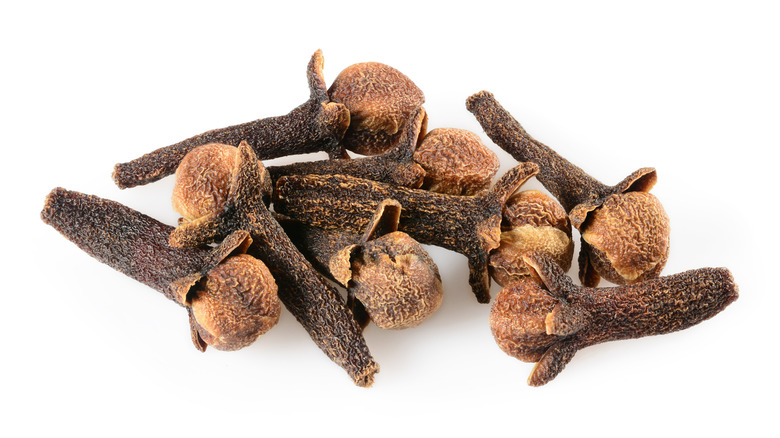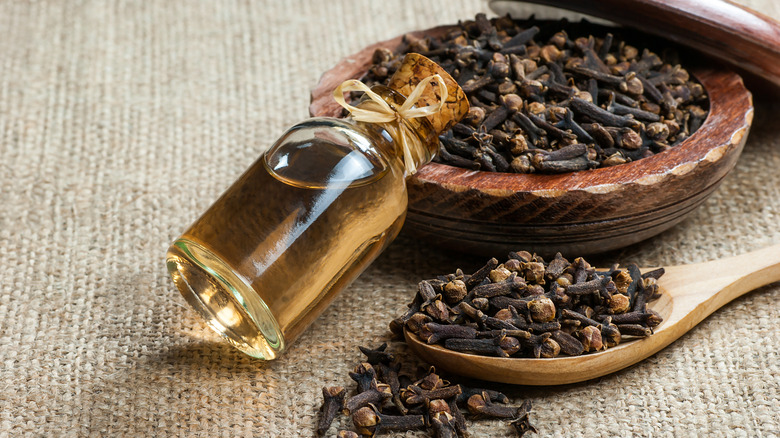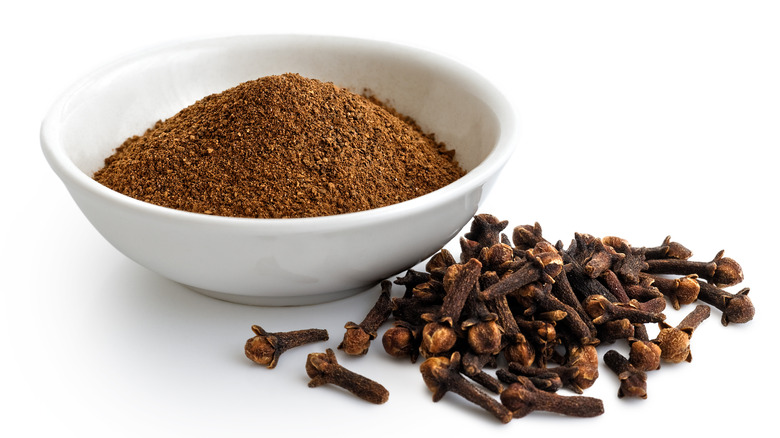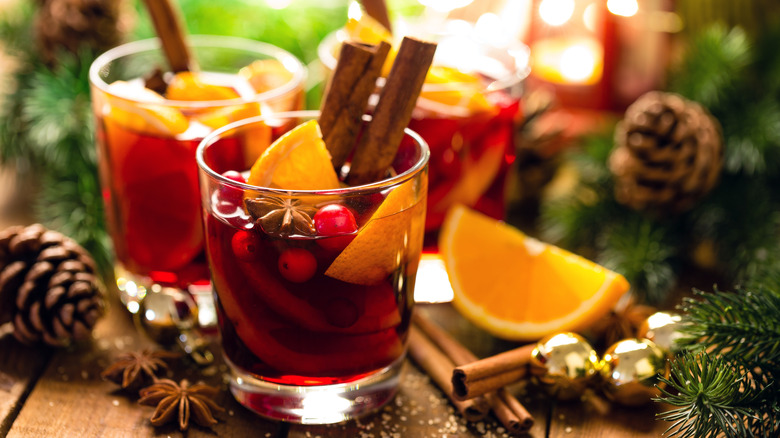What Are Cloves And How Do You Use Them?
Ah, cloves. The pushpin of the spice world. These little beauties are actually flower buds that haven't popped. They come from an evergreen bush that belongs to the Myrtle tree family and are known in scientific circles as Syzygium aromaticum, if you're into that sort of thing (via United States Department of Agriculture).
The unopened flower buds, when dried, resemble tiny microphones, with little round heads atop a stick stem. Fun fact: those four little spikes that stick out at the top are there to protect the flower while it grows inside the bud, isn't that sweet? According to Plants of the World Online, clove is native to the Indonesian Maluku Islands, where it was exclusively found until the 17th century. These days, however, the spice is readily available at your nearest grocery store, where it is sold in both ground or whole form. Cloves add a strong, pungent flavor to everything from meat to chai to seasonal pies.
A history of cloves
Though (as stated above) the clove tree originated in the Maluku Islands of Indonesia, the spicy plant can now be found in a multitude of tropical locations — from parts of the Caribbean to Zanzibar, per Plants of the World Online. The spread of clove trees wasn't exactly your standard birds-and-bees, pollination fairy tale, however. Long before they could be found in your spice rack, cloves were at the center of European trade wars.
In the 17th century, European nations that wanted control of the spice trade went to war over the humble clove, and other spices like it. According to MasterClass, cloves had been used in China for centuries for both culinary and medicinal purposes (plus, you'd have to pop a few cloves before your meeting with the emperor to ensure fresh breath), and European colonialist powers were starting to take notice. By the time the spice wars rolled around, cloves were such a hot ticket item that the Dutch even went so far as to set fire to any clove tree that wasn't growing in Dutch-occupied territory, in order to monopolize the market.
What do cloves taste like?
Before you go munching a few cloves á la the ancient Chinese, bear in mind that these little nail-shaped spices taste like just that — nails. Well, not exactly, but on their own, whole cloves are very bitter-tasting. Used properly, however, these aromatic little guys add spice and warmth to a variety of sweet and savory dishes, whether you ground them first or add them whole (taking care to remove the buds before eating).
Adding cloves to a dish or drink might conjure that warm-by-the-fire sensation. The spice might be too pungent to eat, but like cinnamon or ginger, it will add a richness to whatever you're cooking, giving it that earthy sweetness and instantly making the flavor more complex. If you've ever had fresh gingerbread, a good curry, or a baked ham where you can't quite put your finger on what made it so warm and Christmassy, that sweet-spicy flavor was probably the result of a clove or two.
Nutritional information about cloves
According to Healthline, there are many reasons you might want to stick a few cloves in your tea or chutney, and not just for that spicy kick of flavor. Cloves help stop the growth of bacteria and encourage healthy blood sugar levels, plus some research has shown that the eugenol oil that cloves produce has anti-cancer properties in lab settings. Cloves are generally used in such small amounts that they are not going to replace the nutrients your body gets from other foods, but that doesn't mean they're not filled with good and good-for-you things.
Cloves are rich in manganese, a mineral that helps to build strong bones and maintain brain functionality. In fact, just a single teaspoon of ground cloves contains 55% of the daily value of manganese. Cloves also have antimicrobial properties that kill bacteria, which is why they were used as an oral antiseptic in ancient China. Test tube and animal studies have shown that clove extracts also help to increase bone mineral density (due to the manganese), protect against stomach ulcers, and improve liver health due to the antioxidants they contain. Not bad for tiny little tacks.
How to cook with cloves
Speaking of tacks, if you're using whole cloves, you're going to want to imagine your food is a bulletin board. The hard stem of a clove should be pushed into the soft flesh of whatever you are adding them to, as if they were tiny, organic pushpins. For example, if you're making a good hot toddy (of which cloves are an essential ingredient), you will want to push whole buds into the flesh of the lemon or orange slices you're using, so that the head protrudes. You may also want to stud a glazed ham with cloves before roasting it, or stick them into an apple for your mulled wine.
For fresh flavor without biting into these bitter little sticks, grind your cloves with a mortar and pestle first. Cloves can also be purchased ground if you want to save yourself the work, but either way, you're going to want to have cloves on hand around the holidays. Whole or ground cloves are called for in most of your seasonal favorites, like pumpkin pie and eggnog. Plus, they're used in chais, ciders, and Christmas cocktails, where they take something like a hot buttered rum or eggnog to the next level.




